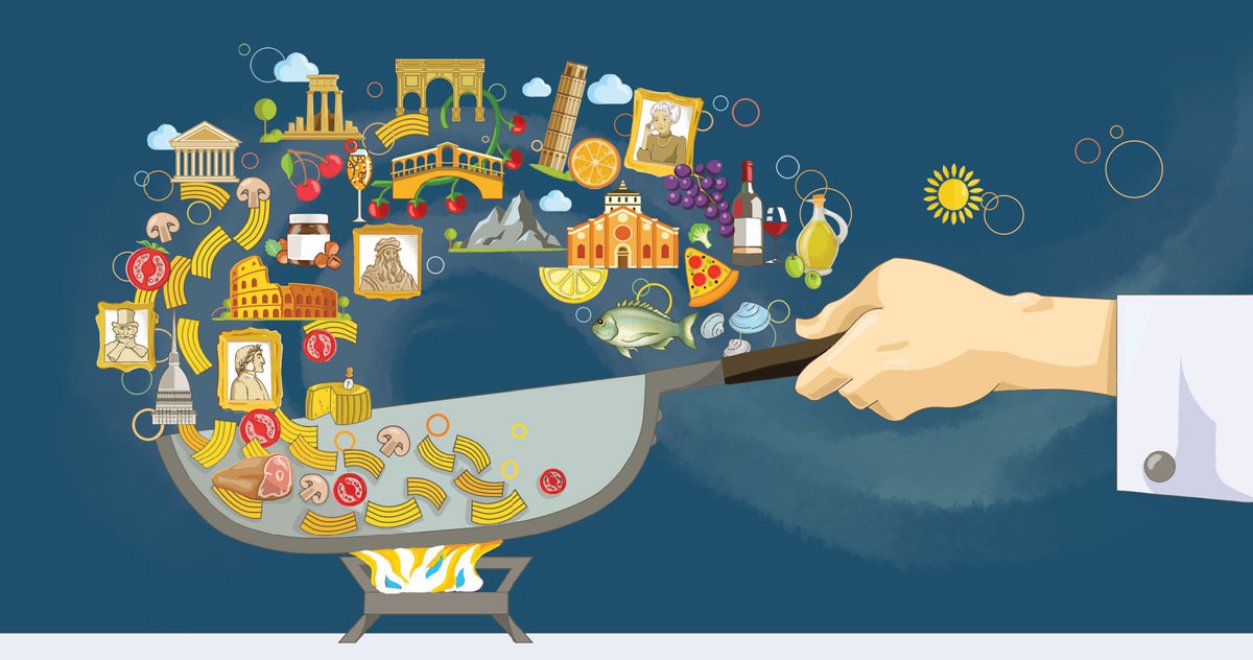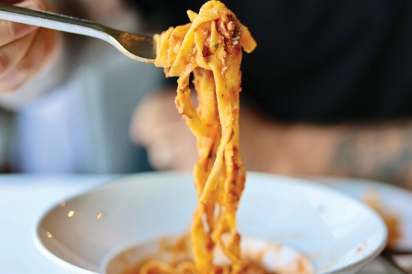A Tavola con la Cuscina Intaliana
ITALIAN CUISINE is one of the most celebrated cuisines in the world, with an abundance of delectable recipes from every region and to fit every palate. But what is the structure of a traditional Italian meal? By traditional, I mean Sunday lunch with family or a dinner with invited guests, not your usual weekday lunch, which we call an insalata condita—a salad with various additions— or a tramezzino, a delicious sandwich filled with a variety of cold fillings, such as tuna and artichokes or tuna salad, mozzarella and tomato, prosciutto and formaggio. Nor is it the usual dinner meal of a two-income family, which often consists of a one-dish meal.
No, we’re going to explore the full I-need-a-two-hour-nap-after meal that preferably requires an Italian mamma or nonna to prepare, or at least someone who loves to cook.
I need to preface it with two points: First, Italian food is all about using regional, seasonal ingredients; and second, Italian food is essentially healthy. Sure, you’ll find a fried dish here and there (we’re not saints), but an Italian diet is also very vegetable friendly and fiber-rich, filled with antioxidants, good fats and few processed ingredients. So traditional Italian cuisine is fresh and healthy and should not be confused with Americanized Italian food (estimated to be on average 82% more calorific), which can also be delicious but less good for your body.
Also, keep in mind portion size, because although the below will seem like a lot, the size of the dishes is drastically smaller than their American counterparts’ servings.
So, how do we eat? Let’s break it down by course:
APERITIVO: This course precedes dinner. It usually means a glass (or two) of prosecco or an Aperol Spritz and little snacky foods that don’t require cutlery: olives, nuts, maybe some mini pizzas or bruschetta, sometimes a prosciutto and cheese platter accompanied by crackers.
ANTIPASTO: This is the first course that you have seated at the table. Sometimes the prosciutto platter is served here if it’s particularly ingredient-heavy and would require a plate—if the cheeses are accompanied by honeys and jams; if there is vegetable giardiniera or giant capers from Pantelleria or more olives and lupini beans; if there are numerous cold cuts spanning from prosciutto to salami to bresaola. Antipasto basically means a starter and what it includes depends on the region of Italian cuisine (this can span from a vitello tonnato from Piedmont to a Sicilian arancina) and by the type of meal. If you are serving a course of fish or seafood, your antipasto should follow suit: an insalata di mare (seafood salad) or lobster and potato astice alla catalana or impepata di cozze (peppered mussels).
PRIMO: A “first” dish usually is a pasta or a polenta or a minestrone or some other soup. It could be a risotto, but it’s rare because the preparation requires the cook to spend so much time in the kitchen, away from their guests. Pasta is the king of primos, and the most widespread, not only because it’s the most loved, but because it can be made ahead if it’s baked (a lasagna or a sformato) and because it doesn’t have to be supervised while it boils—you just need to step into the kitchen for the mantecatura, which is when you sauté the drained pasta in your sauce. (This is how to prepare pasta, as opposed to pouring the sauce on top of drained, plated pasta.) Pasta also provides limitless options because we have hundreds of types: long, short, dry, egg pasta, in a cornucopia of shapes… and people get very particular about the type of pasta to pair with sauce. Spaghetti alle vongole (with clams) or penne alla vodka (with vodka sauce) would only ever be done with those specific types of pasta. I, personally, would eat ragù alla Bolognese (the real bolognese sauce) only with long pasta, preferably fettuccine egg pasta (possibly freshly made by myself, but I don’t always have the time).
SECONDO: This is the equivalent of a main dish, and the options are endless and often regional, as the names give away: saltimbocca alla romana, ossobuco alla Milanese, pesce spada alla siciliana, baccalà mantecata alla veneziana. The main can be vegetarian friendly, because Italy is the country with the highest number of edible plants in the world, so main dishes could be a vegetarian melanzane alla parmigiana or a vegan caponata.
CONTORNO: This is the side dish that accompanies the main, and usually consists of a vegetable, legumes and grains. Some are traditional accompaniments: Fiorentina steak usually gets a cannellini bean contorno; roast potatoes with lamb. Most are about balancing the dish. So, if the protein is particularly flavorful you will want to pair it with something more delicate and sweet. Salad is the contorno of choice if you are eating a fatty main.
INSALATA: Salad as its own course is not Italian, even though every Italian-American dinner party I’ve ever been invited to has it as its own course, with the exception of if the salad is your entire meal. Many Italians will keep lunch light with a salad, adding a variety of veggies and maybe some tuna or mozzarella to it, traditionally never dressed with a creamy sauce but preferring a beautiful olive oil and vinegar (often balsamic) homemade dressing.
DOLCE: Dessert! Go to an Italian restaurant abroad and this means tiramisu and panna cotta. And while for sure these are favorites, they don’t even begin to open you up to the world of Italian desserts, which, like other courses, are regional (from Piedmonts’ bonnet to Sicilian cannoli by means of pastiera Napoletana) and seasonal. There are those that are carted out on specific holidays (bigne di san Giuseppe for Father’s Day, frappé for Carnevale). In the summer months, especially, desserts are fruit-based, or fruit is offered as well as dessert, with Macedonia di frutta (fruit salad) being very widespread.
CAFFÈ E AMMAZZACAFFÈ: Coffee often ends the meal and is usually accompanied by a “coffee killer” (ammazzacaffè). That’s what we call the digestif or liquor that is usually served at the end of the meal. If you are in Naples this is limoncello; in much of the north it’s grappa, in Sardegna it’s Mirto… Sambuca, Amaro, dessert wines (from Vin Santo to Passito).
Traditionally a meal like this is served family style, with serving plates passed from guest to guest and then set in the middle for anyone to take seconds. This is true per course, with each platter taken away before the next one arrives, with the exception of the second and the contorno (which can be more than one) being served together. And wine is always there to accompany your meal, sometimes changed based on what course you are on.
An Italian table is always beautiful. Italians say that we also eat with our eyes, so the table must be aesthetically pleasing as well, and Italians take great pride in showing off their plateware and adorning the table with beautiful fresh cut flowers. This is to create the perfect ambiance to enjoy a couple of hours at the table, where business deals are made and family announcements celebrated. The shared values of sitting around a table are symbolic of Italy’s philosophy of appreciating what’s in front of you and taking time for those you love the most.
All of the above considered, it’s not a surprise that the Italian government nominated Italian cuisine to be part of UNESCO’s Intangible Cultural Heritage of Humanity list, based not only on the recipes but also the social practices, rituals and impact on shaping biocultural diversity. And since writing this article has now made me ravenous, I’m off to my kitchen to go make some fettuccine.
Allegra Baistrocchi is the Consul of Italy in Detroit. The Consulate of Italy in Detroit is a government entity tasked with providing services (passports, visas, consular assistance) and promoting Italian language and culture in a consular jurisdiction that includes Michigan, Ohio, Indiana, Kentucky and Tennessee. Learn more about our “Week of Italian Cuisine in the World” in November and other events at @ItalyinDetroit.






